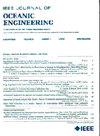Potential-Game-Driven Formation Control of AUVs: An Inverse-Reinforcement-Learning-Based Solution
IF 3.8
2区 工程技术
Q1 ENGINEERING, CIVIL
引用次数: 0
Abstract
The formation control of autonomous underwater vehicles (AUVs) is widely used to perform complex maritime missions. However, most works simply add all individual interests of AUVs together to achieve the formation task, which cannot reveal their interaction relationship and guarantee the full exploitation of formation interests. In this article, we are concerned with a potential-game-driven formation issue for AUVs. Specifically, a potential game-driven formation framework is first developed to formulate the decision-making procedure of AUVs, where the cost function not only reflects the common formation objective but also captures the self-interest. Based on this, the formation optimization problem of AUVs is constructed. To solve the aforementioned problem, an inverse reinforcement learning (IRL)-based formation controller is designed, whose aim is to maximize the formation benefits and drive AUVs to the desired formation shape. Besides that, the theory analyses, including the satisfiability of the potential game, the accessibility of the Nash equilibrium, and the convergence of the formation controller, are provided. The main innovations of this article are as follows: 1) the potential-game-driven framework can fully exploit individual AUV interests and enhance formation robustness over traditional cooperative frameworks and 2) the IRL-based formation controller has better environmental adaptability to the unknown underwater environment compared with traditional reinforcement learning controllers. Finally, simulations and experiments are conducted to validate the effectiveness of our solution.潜在博弈驱动的auv编队控制:一种基于逆强化学习的解决方案
自主水下航行器(auv)的编队控制被广泛用于执行复杂的海上任务。然而,大多数工作只是简单地将水下机器人的所有个体利益加在一起来完成编队任务,无法揭示它们之间的相互作用关系,保证编队利益的充分利用。在本文中,我们关注的是auv潜在的游戏驱动的队形问题。具体而言,首先建立了一个潜在博弈驱动的编队框架来制定auv的决策过程,其中的成本函数不仅反映了共同的编队目标,而且反映了自身利益。在此基础上,构建了水下机器人的编队优化问题。为了解决上述问题,设计了一种基于逆强化学习(IRL)的地层控制器,其目的是最大化地层效益,并将auv驱动到期望的地层形状。在此基础上,对潜在对策的可满足性、纳什均衡的可达性和编队控制器的收敛性进行了理论分析。本文的主要创新点在于:1)潜在博弈驱动框架比传统合作框架更能充分挖掘AUV个体兴趣,增强编队鲁棒性;2)基于irl的编队控制器比传统强化学习控制器对未知水下环境具有更好的环境适应性。最后通过仿真和实验验证了该方法的有效性。
本文章由计算机程序翻译,如有差异,请以英文原文为准。
求助全文
约1分钟内获得全文
求助全文
来源期刊

IEEE Journal of Oceanic Engineering
工程技术-工程:大洋
CiteScore
9.60
自引率
12.20%
发文量
86
审稿时长
12 months
期刊介绍:
The IEEE Journal of Oceanic Engineering (ISSN 0364-9059) is the online-only quarterly publication of the IEEE Oceanic Engineering Society (IEEE OES). The scope of the Journal is the field of interest of the IEEE OES, which encompasses all aspects of science, engineering, and technology that address research, development, and operations pertaining to all bodies of water. This includes the creation of new capabilities and technologies from concept design through prototypes, testing, and operational systems to sense, explore, understand, develop, use, and responsibly manage natural resources.
 求助内容:
求助内容: 应助结果提醒方式:
应助结果提醒方式:


